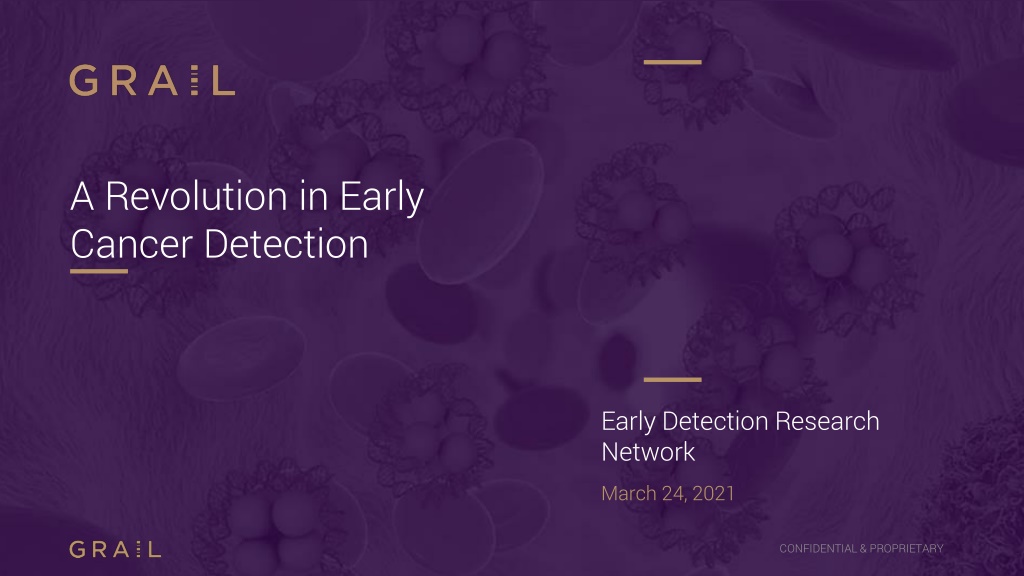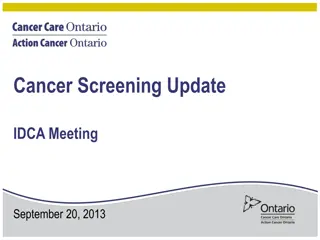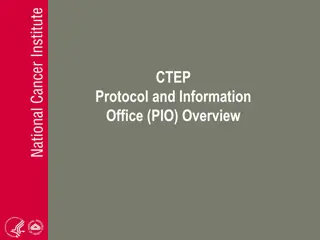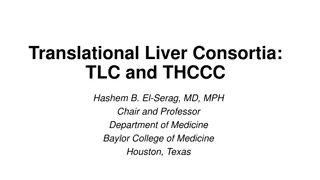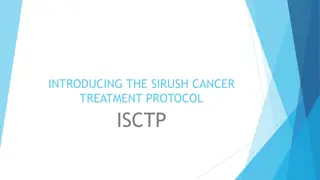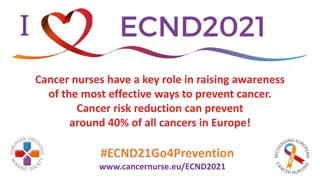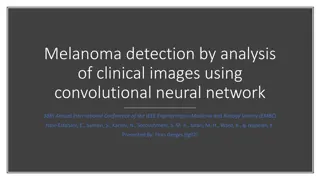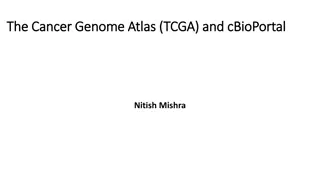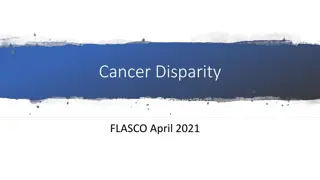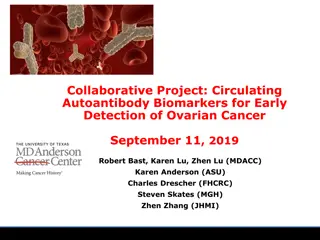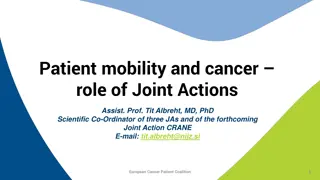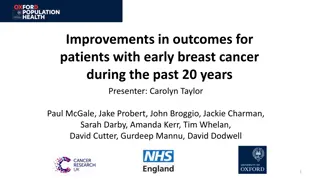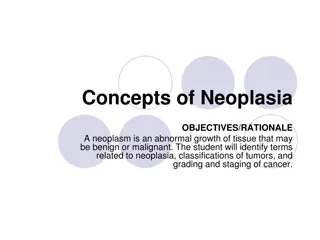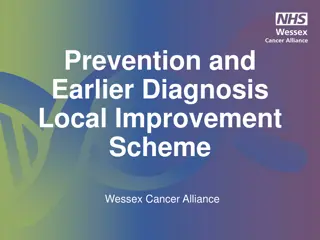Revolution in Early Cancer Detection Research
The presentation discusses the importance of early cancer detection and the high mortality rates associated with late-stage diagnoses. It highlights the current single cancer screening tests, their compliance rates, and their effectiveness in detecting various types of cancer. The data presented underscores the critical need for improved screening methods to save lives.
Uploaded on Feb 20, 2025 | 1 Views
Download Presentation

Please find below an Image/Link to download the presentation.
The content on the website is provided AS IS for your information and personal use only. It may not be sold, licensed, or shared on other websites without obtaining consent from the author.If you encounter any issues during the download, it is possible that the publisher has removed the file from their server.
You are allowed to download the files provided on this website for personal or commercial use, subject to the condition that they are used lawfully. All files are the property of their respective owners.
The content on the website is provided AS IS for your information and personal use only. It may not be sold, licensed, or shared on other websites without obtaining consent from the author.
E N D
Presentation Transcript
A Revolution in Early Cancer Detection Early Detection Research Network March 24, 2021 CONFIDENTIAL & PROPRIETARY
Disclaimer and Disclosure THE CONTENT OF THIS PRESENTATION IS THE CONFIDENTIAL & PROPRIETARY INFORMATION OF GRAIL. INFORMATION DISCLOSED OR DISCUSSED IN THIS PRESENTATION IS SUBJECT TO OBLIGATIONS OF CONFIDENTIALITY AND IS NOT TO BE DISCUSSED, SHARED, OR FORWARDED. THE TECHNOLOGY AND ANY PRODUCT(S) DISCUSSED IN THIS PRESENTATION ARE INVESTIGATIONAL AND THEIR SAFETY AND EFFECTIVENESS HAVE NOT YET BEEN ESTABLISHED. THE DATA PRESENTED ARE PRELIMINARY. CONFIDENTIAL & PROPRIETARY 2
Late stage cancer detection is deadly Low 5-year cancer-specific mortality when diagnosed early High 5-year cancer-specific mortality when diagnosed late 11% 11% 79% 79% Distant Metastases Localized 71% of cancer of cancer- -related deaths today are in cancers with no recommended screening related deaths today are in cancers with no recommended screening Surveillance, Epidemiology, and End Results (SEER) Program (www.seer.cancer.gov) SEER*Stat Database: Incidence - SEER 18 Regs Research Data, Nov 2018 Sub. Includes persons aged 50-79 diagnosed 2006-2015 Early/Localized includes invasive localized tumors that have not spread beyond organ of origin, Late/Metastasized includes invasive cancers that have metastasized beyond the organ of origin to other parts of the body. Noone AM, Howlader N, Krapcho M, et al. (eds). SEER Cancer Statistics Review, 1975-2015, National Cancer Institute, Bethesda, MD, http://seer.cancer.gov/csr/1975_2015/, based on November 2017 SEER data submission, posted to the SEER website April 2018. 3 CONFIDENTIAL & PROPRIETARY
Current single cancer screening tests Compliance With Recommended Screening (%)6 USPSTF Positive Predictive Value (%) Cancer Prevalence (%) Recommended Screening Sensitivity (%) Specificity (%) Biennial mammography, women ages 55 79 Breast1 0.6 87 89 4.4 78.3 Triennial cytology or quinquennial cytology/HPV test, women ages 21 65 Cervical2 <0.1 95 85.5 <1% 80 Decennial Colonoscopy Reference Reference Reference Triennial Stool-based screening (Cologuard) Colorectal3 0.65 92.3 86.6 3.7 69.7 Annual Stool-based screening (FIT) 73.8 94.9 8.7 Annual low-dose CT for high-risk persons ages 55 805 Lung4 1.1 (high risk) 85 87 6.9 5 CT, computed tomography; FIT, fecal immunochemical test; HPV, human papillomavirus; USPSTF, United States Preventive Services Task Force. 1USPSTF. 2016. Lehman, et al. Radiology. 2017;283(1):49-58. 2Kim, et al. JAMA. 2018;320(7):706-714. 3USPSTF. 2017. United States Food and Drug Administration Premarket Approval P130017. Accessed March 26, 2019. Cologuard Test. Available from www.cologuardtest.com/hcp/crc-screening-redefined. Accessed March 26, 2019. 4Fedewa, Stacey A., et al. "State Variation in Low-Dose Computed Tomography Scanning for Lung Cancer Screening in the United States." JNCI: Journal of the National Cancer Institute (2020).5Pinsky. J Med Screen. 2012;19(3):154-156. Recommendation for lung screening limited to high-risk smoking population, which accounts for less than 33% of all lung cancers 6Compliance from BRFSS Prevalence & Trends Data. 2015. [accessed Aug 12, 2020]. URL: https://www.cdc.gov/brfss/brfssprevalence/ except LDCT from Zahnd, et al. Am J Prev Med 2019;57(2):250 255. 7Wolf et al. CA Cancer J Clin 2010;60:70 98 CONFIDENTIAL & PROPRIETARY 4
The incidence rate of non-colorectal cancer is 10-fold higher than that of colorectal cancer in the screening population1 Per 100,000 (50-79 years) Crude Incidence Rate Cancer targeted via conventional screening Cancers not targeted by screening *General or average-risk population. 1Surveillance, Epidemiology, and End Results (SEER) Program (www.seer.cancer.gov) SEER*Stat Database: Incidence - SEER 18 Regs Research Data + Hurricane Katrina Impacted Louisiana Cases, November 2018 Submission (2000-2016) <Katrina/Rita Population Adjustment> - Linked To County Attributes - Total U.S., 1969-2017 Counties, National Cancer Institute, Division of Cancer Control and Population Sciences (DCCPS), Surveillance Research Program, released April 2019, based on the November 2018 submission. Individuals aged 50-79 years for 2016 only. CONFIDENTIAL & PROPRIETARY 5
At GRAIL, we see a better way Instead of only screening for individual cancers, we need to Screen Individuals For Cancer CONFIDENTIAL & PROPRIETARY 6
Tracking down cancer in blood Tumors shed nucleic acids into blood and other body fluids, carrying cancer-specific information GRAIL technology evaluated hallmarks of cancer in the blood Mutations (single base changes) Tumor tissue Chromosome alterations (copy number) Plasma cfDNA DNA methylation patterns (chemical modification) Proprietary methylation-based technology selected for development based on results from first sub-study of CCGA CCGA, Circulating Cell-free Genome Atlas study (NCT02889978); cfDNA, cell-free DNA. Figure from Liu MC, et al. Ann Oncol. 2020;31(6):745-759. DOI: 10.1016/j.annonc.2020.02.011. CONFIDENTIAL & PROPRIETARY 7
Methylation outperformed other approaches in identifying and localizing signal Targeted methylation sequencing LOD 10x more sensitive Feature Assay1 Targeted >>30x depth (1M CpGs) CCGA2 Methylation Sequencing Whole Genome Methylation Sequencing 30x WGBS (30M CpGs) CCGA1 Small Variants + WBC noise removal 507 genes (2Mb) 3,000x depth Copy Number 30x WGS Fragment 30x WGS Combining other approaches did not increase methylation-only test performance Limit of Detection 1) Data from CCGA1 and CCGA2. 8 CONFIDENTIAL & PROPRIETARY
Galleri Multi-Cancer Early Detection Test Is Designed To: DETECT most cancers COMPLEMENT not replace recommended single cancer screening tests OPTIMIZE overall cancer detection MINIMIZE harms CONFIDENTIAL & PROPRIETARY 9
GalleriTM: Our investigational multi-cancer early detection test >50 Cancer detected 43% Positive predictive value (modeled) 0.7% False positive rate Sensitivity stages I-III for prespecified cancer types representing of cancer mortality in US 67% 44% Sensitivity stages I-III for all cancer 93% Localization accuracy1 1 Based on tissue of origin class assigned in 96% of cases where cancer was detected. 10 CONFIDENTIAL & PROPRIETARY
Data suggests Galleri could avoid overdiagnosis of indolent cancers Kaplan-Meier curves are adjusted for age and cancer type Stage II Stage I Not detected Detected SEER adjusted for not detected population Stage III Stage IV SEER adjusted for detected population CCGA2, Circulating Cell-free Genome Atlas (NCT02889978) sub-study 2; SEER, Surveillance, Epidemiology, and End Results. 1SEER population adjusted for: age, clinical stage, and cancer type. Data on file. CONFIDENTIAL & PROPRIETARY 11 CONFIDENTIAL & PROPRIETARY
Modeling the Population Impact of the GRAIL Test CONFIDENTIAL & PROPRIETARY 12
Galleri expected to increase total cancer detection ~ 3x when added to recommended single cancer screenings % detected of 1.3M annual US cancers ages 50-79 PPV 1.2% 4.4% 36% 43% Sensitivity 88% 87% 67% 44% 1Liu MC, et al. Ann Oncol. 2020;31(6):745-759. DOI: 10.1016/j.annonc.2020.02.011.2Sensitivity adjusted based on Surveillance, Epidemiology, and End Results (SEER) stage distribution. 3Assumes 99.3% specificity. 4SEER Program (www.seer.cancer.gov) SEER*Stat Database: Incidence - SEER 18 Regs Research Data + Hurricane Katrina Impacted Louisiana Cases, November 2018 Submission (2000-2016) <Katrina/Rita Population Adjustment> - Linked To County Attributes - Total US 1969-2017 Counties, National Cancer Institute, Division of Cancer Control and Population Sciences (DCCPS), Surveillance Research Program, released April 2019, based on the November 2018 submission. Individuals aged 50-79 years for 2016 only. 13 13 CONFIDENTIAL & PROPRIETARY
Galleri has the potential to identify more cancers more efficiently Modeled diagnostic workup cost* per cancer diagnosed could be reduced by 65% when combined with single cancer screening $25B spent annually in US on diagnostic workup services* for single cancer screenings False positives (in millions) True positives (in 000 s) Galleri Single cancer screening 1,000 10 Single cancer screening alone estimated: ~$89,000 in diagnostic work-up services* per cancer diagnosed 9 0.74M 900 800 8 700 7 329K cancer types which lack screening guidelines 600 6 Galleri could contribute to fractional increase in false positives 500 5 447K 8.7M 400 4 300 3 Galleri + single cancer screening estimated: ~$32,000 in diagnostic work-up services* per cancer diagnosed 200 2 206K 100 1 0 0 1 Based on SEER incidence of population 50 years. Data on file. Assumes nationally representative adherence to USPSTF recommended screening (breast, colorectal, lung, prostate and cervical cancer) and 100% screening with GRAIL test in the USPSTF screened group. *These costs include downstream workup costs after initial screening test 14 CONFIDENTIAL & PROPRIETARY
Galleri has the potential to save lives Galleri detected majority of cancers in early stages1 Adding Galleri to 5 US recommended screenings could potentially avert 100K deaths annually Expected proportion of 5-year deaths averted in detected cancers Number of diagnoses per 100k 39% 39% Averted Deaths Modeling the addition of Galleri to Modeling the addition of Galleri to standard US screening standard US screening 1Liu MC et al, Ann Oncol. 2020;31(6):745-759. DOI:10.1016/j.annonc.2020.02.011 15 CONFIDENTIAL & PROPRIETARY Data on file.
Thank you CONFIDENTIAL & PROPRIETARY 16
Appendix CONFIDENTIAL & PROPRIETARY 17
GRAIL, Inc. Formed in January 2016 to take on one of the world s biggest challenges - cancer Headquartered in Silicon Valley at the heart of the intersection of the life sciences and technology industries A world-class team of leaders, scientists, clinicians, engineers, and other experts CONFIDENTIAL & PROPRIETARY 18
Background on the Clinical Value of Multi-Cancer Early Detection CONFIDENTIAL & PROPRIETARY 19
Background on GRAILs Approach to the Genome CONFIDENTIAL & PROPRIETARY 20
Clinical development program Test development, validation, and implementation in population-scale studies CCGA (n=15,254) NCT02889978 Develop and validate a cell-free DNA-based MCED test 1 STRIVE (n=99,308) NCT03085888 Clinical validation in women undergoing mammography screening 2 Expected completion: March 2024 Expected completion: May 2025 >145,000 participants PATHFINDER (n 6,600) NCT04241796 Assess clinical implementation and perceptions of MCED test 4 SUMMIT (n 25,000) NCT03934866 Clinical validation in individuals at high risk of lung cancer 3 Expected completion: December 2021 Expected completion: August 2030 CCGA, Circulating Cell-free Genome Atlas; MCED, multi-cancer early detection. CONFIDENTIAL & PROPRIETARY 21
NCT02889978 Circulating Cell-free Genome Atlas (CCGA) sub-study 2 Test sensitivity and specificity CCGA 76.4% (71.6-80.7%) sensitivity in pre-specified*cancers (validation set) 54.9% (51.0-58.8%) overall sensitivity in >50 cancers (validation set) Single fixed false positive rate (0.7%) across all cancers All Cancers (>50) Pre-Specified Cancers* 100% 75% Sensitivity 50% 25% Training Set Validation Set 0% I (143 | 62) II (142 | 62) III (241 | 102) IV (302 | 130) I (421 | 185) II (389 | 166) III (313 | 134) IV (363 | 148) Clinical Stage Clinical Stage *Anus, bladder, colon/rectum, esophagus, head and neck, liver/bile-duct, lung, lymphoma, ovary, pancreas, plasma cell neoplasm, stomach. Plot excludes unstaged cancers. Liu MC, et al. Ann Oncol. 2020;31(6):745-759. DOI: 10.1016/j.annonc.2020.02.011. CONFIDENTIAL & PROPRIETARY 23
NCT02889978 Strong detection at early stages (I-III) of pre-specified cancers CCGA Sensitivity Anus (4) 75% Bladder (4) 100% Colon/Rectum (32) 66% Esophagus (31) 77% Head and Neck (13) 62% Liver/Bile Duct (7) 86% Lung (69) 52% Lymphoma (31) 84% Ovary (14) 71% Pancreas (22) 73% Plasma Cell Neoplasm (12) 83% Stomach (5) 40% 0% 25% 50% 75% 100% Liu MC, et al. Ann Oncol. 2020;31(6):745-759. DOI: 10.1016/j.annonc.2020.02.011. CONFIDENTIAL & PROPRIETARY 24
